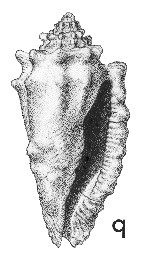
Revised descriptions of New Zealand Cenozoic Mollusca from Beu and Maxwell (1990)

 | Revised descriptions of New Zealand Cenozoic Mollusca from Beu and Maxwell (1990) | 
|
  (Pl. 6q): GS11150, J39/H686, Pareora River near Mt Horrible, Bortonian (GNS) |
Beu & Maxwell (1990): Chapter 7; p. 109; pl. 6 q.
Synonymy: Athleta necopinata Suter 1917, p. 40; Plejona necopinata; Notoplejona necopinata
Type species of Notoplejona Marwick, 1926, synonymised with Athleta Conrad, 1853 by Darragh (1971, p.166-167)
Classification: Volutidae: Athletinae
Description: Small for family (height 30-50 mm), broadly fusiform, spire moderately elevated, about 0.3 total height. Protoconch small, narrowly dome-shaped, of about 3 whorls, last whorl with axial costellae. Teleoconch whorls 5 or 6, convex at first then developing a narrow sutural shelf; last whorl elongate, gently convex, gradually contracted. Axial sculpture commencing as narrow costae reaching from suture to suture, soon developing laterally compressed triangular tubercles on shoulder angle and some distance below (just above suture on spire whorls), costae eventually becoming obsolete in between so that later whorls typically have 2 rows of tubercles without definite interconnecting costae; 8-10 on last whorl. Spiral sculpture of weak threads on spire whorls, more prominent on last whorl, where they consist of low, rounded or flat-topped cords with narrow interspaces, obsolete near middle of whorl on some shells. Aperture rather narrow, anterior end deeply notched, posterior end with shallow sinus. Inner lip heavily callused, some shells with a triangular spur near middle of outer margin of callus; columella almost straight, padded near middle on mature shells and bearing 5 or 6 weak plaits, the anterior one somewhat stronger than the others. Outer lip reflected, with prominent varix, its outer edge crudely nodulose, inner edge finely crenulate. Fasciole ridge-margined.
Comparison: Athleta necopinata is the most elaborately sculptured New Zealand volute and is unlikely to be confused with anything else. The poorly known A. lata (Marwick, 1926) was described from Castle Hill Shaft, Kaitangata (Porangan?); the later record from Otaio Gorge (Marwick 1960, p. 23) was based on A. taikoensis Maxwell, 2003. A. lata differs from A. necopinata in having a lower spire and finer spiral sculpture and in lacking a definite sutural shelf. Maxwell (2003) described three further species of Athleta, occurring in succession in Porangan?-Bortonian rocks at Evans Ford, Pareora River. A. taikoensis occurs in Mangaorapan-Porangan and possibly earliest Bortonian Kauru Formation(?) underlying the Bortonian section at Pareora River, at Otaio Gorge (Mangaorapan), and at Meyers Creek, South Branch Waihao River near "Pentland Hills" Station (probably Mangaorapan); it differs from A. necopinata in its smaller size (height to 40 mm), more restricted spiral sculpture limited to the anterior part of the last whorl, the row of large peripheral nodules, and the callus extending up the spire to cover most of the base of the previous whorl. A. mimica Maxwell, 2003 occurs only in Waihao Greensand (Bortonian) at Waihao Downs, Waihao River, South Canterbury, and at Opuha River, and is very rare at both localities; it is similar to the type species, A. rarispina (Lamarck, 1811) (Miocene, France), and differs from all other New Zealand species (particularly the similar A. taikoensis) in its wider shape, with a more tapered last whorl, large peripheral nodules, heavier apertural callus which, however, does not extend up the spire, and weaker columellar plaits. A. marwicki Maxwell, 2003 occurs only in the upper part of Waihao Greensand at Evans Crossing, Paerora River, and alongside A. necopinata at Waihao Downs, Waihao River. It differs from A. necopinata in a number of minor characters, including its taller spire, its more evenly costate last whorl, its smaller tubercles around the periphery, in lacking a lower row of tubercles on the last whorl, its more prominent spiral sculpture, and its less strongly crenulated outer lip. Intermediate specimens occur in an intermediate stratigraphic position at Pareora River, suggesting that it evolved from A. necopinata, but the occurrence of the two species together at Waihao Downs shows that this was not a simple ancestor-descendent relationship.
Athleta is recorded from Europe, North America, Africa, Asia and Australia and has a stratigraphic range of Late Cretaceous to Recent (Darragh 1971, p . 168), but in New Zealand it is not known after the Bortonian.
Distribution: Bortonian, Waihao Greensand, Waihao Downs (type); Kakahu; Black Point, Bortons; Kakanui River; Pareora River. Moderately common to uncommon at listed localities.
Cite this publication as: "A.G. Beu and J.I. Raine (2009). Revised
descriptions of New Zealand Cenozoic Mollusca from Beu and Maxwell (1990). GNS
Science miscellaneous series no. 27."
© GNS Science, 2009
ISBN
978-0-478-19705-1
ISSN 1177-2441
(Included with a PDF facsimile file
copy of New Zealand Geological Survey Paleontological Bulletin 58 in CD version
from: Publications Officer, GNS Science, P.O. Box 30368 Lower Hutt, New
Zealand)